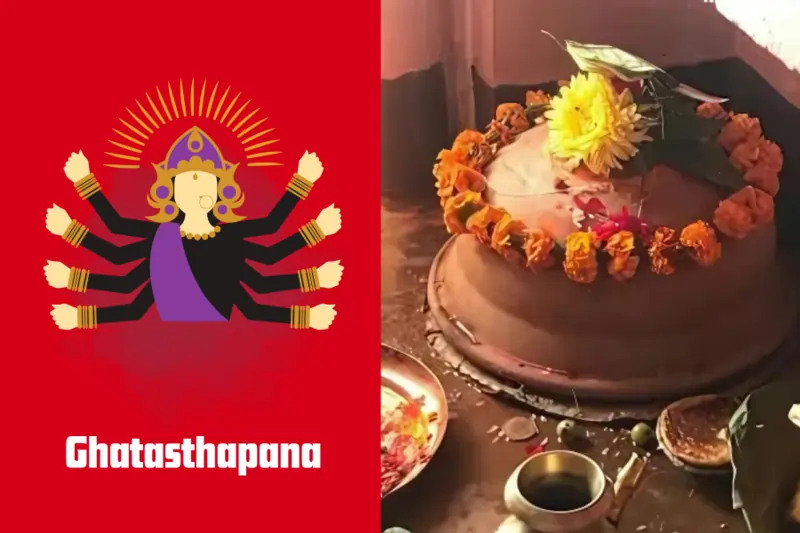The Beginning of Dashain with Ghatasthapana
Ghatasthapana (घटस्थापना) marks the auspicious beginning of Navaratri Puja (नवरात्री पूजा), an integral part of Dashain, in Newari Mohani. It is celebrated on the first day of the Dashain/Mohani festival, on Pratipada of the lunar calendar, which falls in the month of Aswin (September–October). Although Dashain is primarily associated with the mythological stories of Goddess Durga defeating demon Mahishasura and Lord Ram defeating Ravana, symbolizing the victory of divine forces over demonic ones, it also incorporates various religious and philosophical aspects centered around the worship of divine power.
In Nepal, the worship of Nava Durga (the nine forms of Goddess Durga) holds significant importance in this festival. These nine goddesses are Brahmayani, Maheshwari, Kaumari, Vaishnavi, Varahi, Indrayani, Chamunda, Mahalakshmi, and Ugrachandi – ब्रह्मायणी, महेश्वरी, कौमारी, वैष्णवी, बाराही, इन्द्रायणी, चामुण्डा, महालक्ष्मी र उग्रचण्डी. The grand celebration of Dashain begins with the worship of these deities during Navaratri Puja, where each day from the first to the ninth (Pratipada to Nawami) is dedicated to one of these goddesses, accompanied by traditional processions and rituals.
The Ritual of Ghatasthapana
According to our religious traditions, invoking the deity before performing any worship is essential. The primary purpose of this invocation is to bring the deity into proximity and install their divine presence within a sacred object, which is typically represented by a Kalash (sacred water vessel). In spiritual belief, when a deity is invoked and established in the Kalash, all subsequent worship and meditation are centered around it. This Kalash, therefore, symbolically represents the deity itself.
The symbolic nature of this practice is fascinating, and it is the foundation for Ghatasthapana, which initiates Dashain by invoking and establishing the divine presence of Goddess Durga in a Kalash. While Vijaya Dashami is the main day of Dashain, the nine days leading up to it involve a systematic worship of Nava Durga, beginning with Ghatasthapana on the first day, on Pratipada.
On Ghatasthapana, families plant Jamara, Nali Swa in Newari, using barley/corn seeds. The sacred sprout symbolizes prosperity and is used in the rituals of Dashain / Mohani festival rituals.
The Historical Significance of Navaratri Puja
The exact historical origin of Navaratri Puja is unclear. However, references to King Vikramaditya suggest that the tradition of celebrating Dashain had already been established during his reign. The cultural and religious practices of Bhaktapur provide significant insights into the origins of Nava Durga worship in Nepal.
While Bhaktapur’s ancient history is not fully documented, the city’s ruins indicate its long-standing cultural and religious significance. Bhaktapur is uniquely structured in the shape of a conch shell, with sacred shrines dedicated to the Nava Durga goddesses located at strategic points around the city. Every year, grand processions and dances are performed in honor of these deities, reflecting the deep-rooted faith of the people.
According to Tantric texts, the Nava Durga goddesses such as Maheshwari, Kaumari, and others are manifestations of the Bhairavas like Rudra Bhairav, Chanda Bhairav, Unmatta Bhairav, and Kapala Bhairav. This suggests that Bhaktapur, a city deeply embedded in Shaivism and Tantric traditions, was constructed during a time when Tantric practices flourished. Historically, Tantric worship gained significant prominence in Nepal after the Lichhavi period, further solidifying the connection between Navaratri Puja and Tantric rituals.
Bhaktapur as the Center of Navaratri Traditions
Given its deep association with Nava Durga worship, it is highly likely that the practice of Navaratri Puja originated in Bhaktapur. Even today, the rituals followed in Bhaktapur during Dashain remain distinct and more aligned with the true essence of Navaratri compared to other regions.
For example, from Ghatasthapana onwards, each morning a different Nava Durga deity is worshipped, and in the evenings, processions and festivals take place throughout the city. This unique tradition later spread to Kantipur (Kathmandu) and Patan, where symbolic shrines of Durga were established, and people began performing ritualistic bathing in sacred rivers and pilgrimage sites near these shrines.
The Role of Shaivism and State Influence
Bhaktapur, as a former capital, has long been a stronghold of Shaivism. One major reason for this is that ruling kings adopted Shaivism as their state religion. The Malla kings of Bhaktapur considered Taleju Bhawani (Tulja Bhavani) their royal deity. Even though Buddhists celebrate Dashain in their own way, they do not disregard the tradition of Navaratri Durga Puja. Instead, people from various religious backgrounds come together to celebrate Dashain with shared reverence for the goddesses.
This unity suggests that Navaratri Puja was initially established as a royal and public religious tradition in Bhaktapur before the Kathmandu Valley was divided into three kingdoms. If Dashain had been a localized or sectarian festival, it would not have been universally accepted by both Shaiva and Buddhist communities across Nepal. Instead, it would have remained confined to specific regions or groups.
Thus, the grand celebration of Navaratri and Dashain/Mohani reflects Nepal’s deep cultural and spiritual heritage, where the worship of divine feminine energy transcends religious boundaries and unites people in a shared tradition of devotion and festivity.
References
- Nepali Chad-Parbaharu Ko Bibechana, Mana Bajra Bajracharya, 1968

